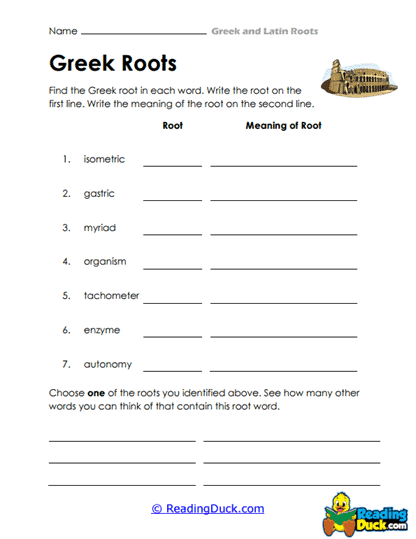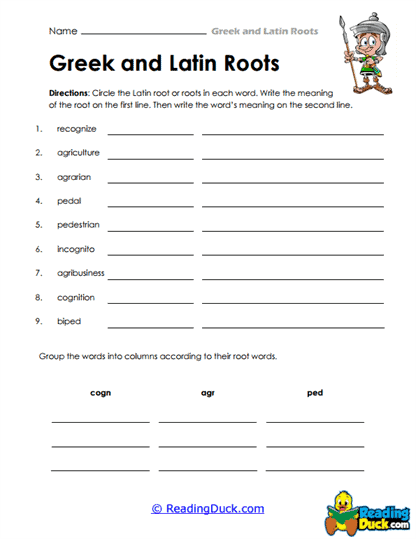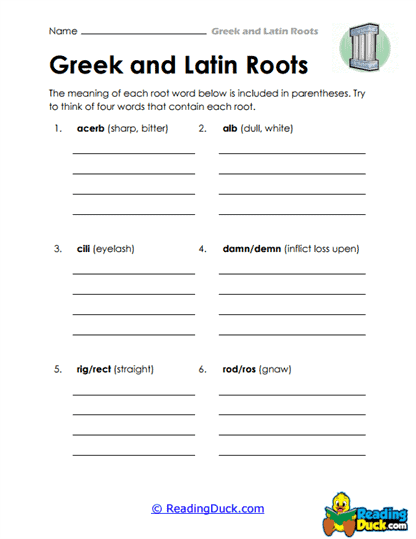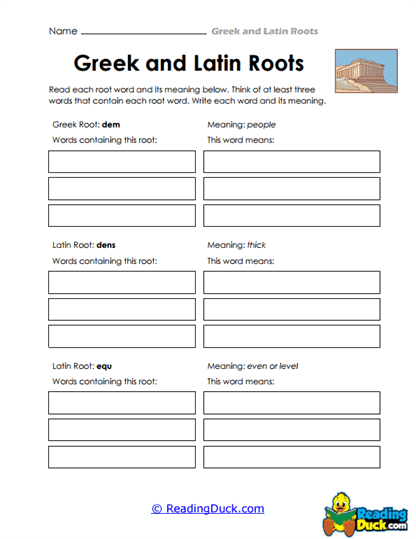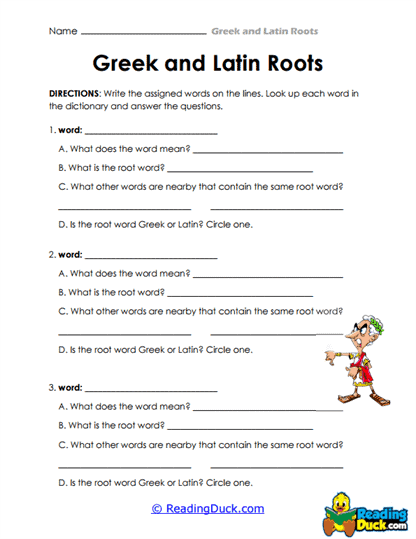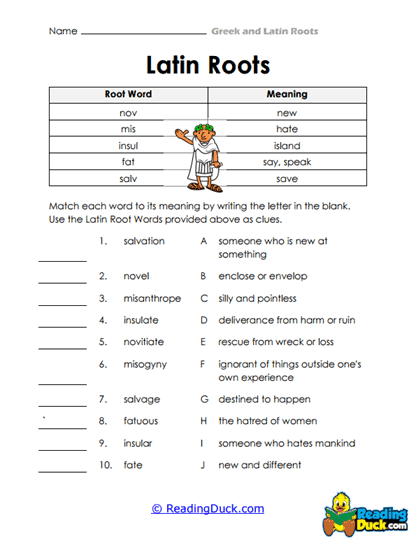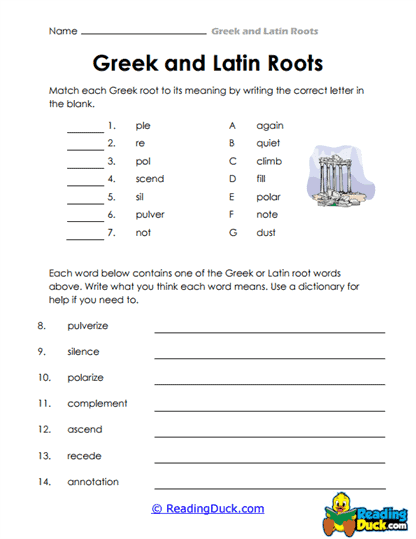Greek and Latin Roots Worksheets
About Our Greek and Latin Roots Worksheets
Our Greek and Latin Roots Worksheets are a valuable resource for students aiming to expand their vocabulary by understanding the foundational roots of many English words. Greek and Latin roots form the basis of a significant portion of the English language, especially in academic, technical, and scientific terms. Mastering these roots gives students the tools they need to decipher unfamiliar words and improve their overall language comprehension.
These worksheets are available in PDF format, making them simple to download, print, and use across a variety of learning environments. Each worksheet includes a downloadable answer key for easy grading and review, allowing teachers, parents, and students to track progress efficiently. By learning Greek and Latin roots, students can significantly boost their vocabulary, enhance reading comprehension, and develop stronger linguistic skills.
Understanding Greek and Latin Roots: A Foundation for Vocabulary Development
Greek and Latin roots are the building blocks of many English words. Understanding these roots allows students to break down complex words into smaller, more manageable parts, making it easier to infer their meanings. For example:
- Tele (Greek root meaning “far”) appears in words like telephone (sound from far) and television (seeing from far).
- Aud (Latin root meaning “hear”) is found in words like audible (able to be heard) and auditorium (a place where people hear something).
Teaching students about Greek and Latin roots is like giving them a toolkit for understanding how words are formed. Some key concepts to introduce include:
- Root Words: The basic meaning of a word often comes from its root. For example, bio (meaning “life”) in words like biology and biography gives us the idea of something related to life.
- Prefixes and Suffixes: These modify the meaning of root words. For instance, adding the prefix pre- (meaning “before”) to the root dict (meaning “say”) forms predict (to say something before it happens).
- Context Clues: Understanding roots helps students use context clues to figure out unfamiliar words in reading passages. For example, encountering the word autograph in a text, knowing that auto means “self” and graph means “write,” students can infer that an autograph is something written by oneself.
By familiarizing themselves with common roots, prefixes, and suffixes, students can approach new vocabulary with confidence, using their knowledge to make educated guesses about word meanings and expand their language skills.
Expanding Vocabulary and Language Comprehension Through Roots
Learning Greek and Latin roots offers students a practical and effective way to improve their vocabulary and language comprehension. The Greek and Latin Roots Worksheets focus on helping students recognize common roots, break down words, and better understand their meanings. This process encourages critical thinking and analytical skills while enhancing word recognition.
Here’s how these worksheets support vocabulary building:
- Word Decoding: When students learn the roots of words, they can decode unfamiliar vocabulary by breaking them into understandable parts. For example, a student who knows that thermo means “heat” and meter means “measure” can easily figure out that a thermometer is a device that measures heat.
- Connecting Word Families: Understanding roots allows students to group words with similar meanings together. For instance, words like predict, dictate, and contradict all share the root dict (meaning “say”), helping students see connections between words.
- Contextual Understanding: As students encounter new words in their reading, they can use their knowledge of Greek and Latin roots to understand the context better. For example, when reading about science, terms like photosynthesis (with photo meaning “light” and synthesis meaning “putting together”) become easier to understand.
For instance, by learning that geo means “earth” and graphy means “writing,” students can quickly grasp the meaning of geography as “writing about the earth.” This methodical approach helps students build a larger vocabulary with less reliance on rote memorization.
Versatile Learning for Any Educational Setting
Our Greek and Latin Roots Worksheets are designed for flexibility, making them an excellent tool for various learning environments. Whether used in a classroom setting, assigned as homework, or utilized for independent study, these worksheets provide a structured and effective way to reinforce vocabulary through word roots.
- In-Class Instruction: Teachers can integrate these worksheets into vocabulary lessons, helping students explore word origins while learning new words. The worksheets can serve as part of a broader lesson on language structure or be used as a quick warm-up activity to start a vocabulary-focused session.
- Homework Assignments: The worksheets make for ideal homework assignments, giving students the opportunity to reinforce their knowledge of word roots outside of class. This independent practice encourages students to apply their root knowledge to new words in their own time.
- Independent Study: Students looking to improve their vocabulary independently will find the worksheets particularly useful. The PDF format allows for easy download and printing, making it simple for students to study on their own or practice wherever they are.
Each worksheet comes with a downloadable answer key, enabling teachers, parents, or students themselves to check their answers and track progress. This versatility ensures that these worksheets are adaptable to various teaching and learning styles, offering a comprehensive approach to vocabulary building.
Real-World Benefits of Learning Greek and Latin Roots
Mastering Greek and Latin roots has far-reaching benefits that extend beyond the classroom. As these roots form the foundation of many academic, scientific, and technical terms, students who understand them are better equipped to navigate complex vocabulary in real-world contexts.
Here are a few practical applications of mastering Greek and Latin roots:
- Enhanced Reading Comprehension: Many technical and academic texts use words derived from Greek and Latin. For example, scientific words like hydrology (the study of water) or medical terms like arthritis (inflammation of the joints) become easier to understand when students know their roots. This improved comprehension boosts reading efficiency in subjects like science, history, and literature.
- Improved Writing Skills: A strong vocabulary allows students to express their ideas more clearly and persuasively. By understanding the roots of words, students can choose more precise language in their writing. For example, knowing that bene means “good” allows students to use words like beneficial or benevolent with confidence in their essays or reports.
- Effective Communication: Whether in everyday conversations or professional settings, having a deep understanding of words helps students communicate more effectively. Understanding word origins allows students to use the right words in the right contexts, avoiding misunderstandings and enhancing clarity.
In fields such as law, medicine, engineering, and technology, knowing Greek and Latin roots is particularly useful, as much of the terminology in these disciplines is rooted in these ancient languages. For example, in biology, words like genetics, photosynthesis, and herbivore are all based on Greek or Latin roots. Mastery of these roots gives students an edge in understanding complex terminology in their future studies or careers.
Preparing for Standardized Tests with Greek and Latin Roots
Knowledge of Greek and Latin roots is invaluable for students preparing for standardized tests such as the SAT, ACT, and TOEFL, where vocabulary comprehension is often a critical component. The Greek and Latin Roots Worksheets help students build a solid foundation in understanding word meanings, usage, and relationships, which is essential for success on these exams.
Here’s how learning Greek and Latin roots can support standardized test preparation:
- Vocabulary Expansion: Standardized tests often include advanced vocabulary. By mastering common roots, students can quickly break down difficult words and infer their meanings, improving their performance in vocabulary sections.
- Word Relationships: Many tests assess a student’s understanding of word relationships, such as synonyms and antonyms. Knowing the roots of words helps students identify these relationships more effectively. For example, knowing that mal means “bad” helps students recognize that malicious and malevolent are related in meaning.
- Context Clues: Standardized reading comprehension sections often require students to understand vocabulary in context. By knowing roots, prefixes, and suffixes, students can use context clues to decipher unfamiliar words in reading passages, helping them answer questions more accurately.
By regularly practicing with the worksheets, students will develop the vocabulary skills they need to approach test questions with confidence, improving their chances of success on exams that play a crucial role in college admissions and other academic opportunities.
Mastering Vocabulary Through Greek and Latin Roots
Our Greek and Latin Roots Worksheets provide an engaging and effective way for students to enhance their vocabulary, improve reading comprehension, and strengthen their linguistic abilities. Available in PDF format, these worksheets are designed for flexible use, making them ideal for classrooms, homework, or independent study.
By mastering Greek and Latin roots, students gain valuable skills that extend far beyond vocabulary lessons. These roots form the foundation of many academic and technical terms, giving students the tools they need to decode complex words, improve their reading comprehension, and communicate more effectively in both written and spoken language. Whether preparing for standardized tests, improving writing skills, or expanding academic knowledge, students will benefit from the structured approach offered by these worksheets.
Through consistent practice, students can build a strong foundation in word origins, giving them the confidence to tackle new vocabulary with ease and setting them up for success in their educational journey and beyond.
